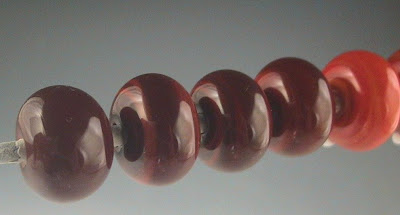It's actually blue, and I burnt the sh1t out of it.
:-P
 Hence the weird, blue creature. Which was supposed to be a cat - then a bunny - then - GOK what. Asphyxia, the bunny rabbit. Flopsy, Mopsy and Asphyxia.
Hence the weird, blue creature. Which was supposed to be a cat - then a bunny - then - GOK what. Asphyxia, the bunny rabbit. Flopsy, Mopsy and Asphyxia. Upon closer inspection - I realized that the streakiness - behind the eyes - was actually from me working too hot.
Upon closer inspection - I realized that the streakiness - behind the eyes - was actually from me working too hot.I was burning the glass.
 Bleh!
Bleh!Once I figured this out, and turned down the flame - I was fine. I stopped getting smokey grey streaks.

Last time I did anything like that was the first time I sat down at a Barracuda (torch) (about 3 years ago!) - and I was using Effetre Periwinkle. I didn't even know that I could burn that colour. D4mn - was I out of control of that - I dripped more on the desk than I got on the mandrel.
I have better control now - but apparently - I can still burn opaque blue.
This glass is really, really, really soft, too. I'm tempted to say - softer than white. It literally took longer for the spacers to cool down and stop moving than it did to melt the gather and make the next one.

These are encased - came out a little lighter. These are encase in Lauscha clear, btw.
Please note that by then - I had the burning/smoking under control.
These are the unencased spacers, next to the unworked rods. They haven't changed colour much. Why I thought the glass was grey - who knows. Maybe because I was going to turn it grey with smoking it. Maybe my memory was working backwards - remembering the future.
 Right.
Right.Maybe I have a future writing about time travel. Or is that a history of writing it?
And here we have with black dots, and the Glacier dotted on top of the black. The

black and the Glacier have interacted - especially with the small, thin dots on top of the black. Notice the weird, creepy looking mouth that seems to have formed in the middle of the centre dot on the lower bead, with the dots on the upper bead have formed eyes.
Looks positively possessed.
It's a nice pastel shade of blue. I wouldn't say pass on it, just because my experience with it was odd!
It was, fair to say, perhaps not my best night at the torch?
Hey - if you are working on a small torch with a small flame - you'll probably love this glass!











































